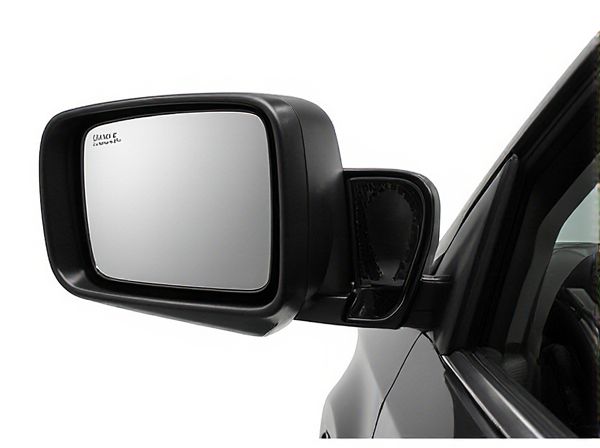
Photo illustration: Turn Signal Mirror vs Non-Turn Signal Mirror
Turn signal mirrors enhance vehicle safety by integrating LED indicators, making your intentions more visible to other drivers and pedestrians. Non-turn signal mirrors lack this feature, potentially reducing communication clarity and increasing the risk of accidents during lane changes or turns. Choosing turn signal mirrors can improve road awareness and contribute to a safer driving experience.
Table of Comparison
| Feature | Turn Signal Mirror | Non-Turn Signal Mirror |
|---|---|---|
| Safety | Enhanced visibility; signals turn intentions to other drivers | No built-in signaling; relies on vehicle's main turn signals |
| Signal Integration | Integrated LED or bulb turn signals on mirror housing | No integrated signals |
| Cost | Higher price due to added technology | Lower cost, basic mirror design |
| Aesthetics | Modern look; complements vehicle design with lighting | Standard appearance without lighting features |
| Installation | May require professional or specialized installation | Simple installation, usually plug-and-play |
| Durability | Additional electrical components might affect longevity | Fewer components, generally longer lasting |
| Compatibility | Specific to vehicle models with turn signal wiring | Compatible with most vehicles without wiring modifications |
Introduction: The Importance of Mirror Features
Turn signal mirrors enhance vehicle safety by providing integrated indicators that improve visibility and communication with other drivers. Non-turn signal mirrors lack this feature, potentially reducing alertness during lane changes or turns. Choosing mirrors with signal lights contributes to accident prevention and complies with modern automotive safety standards.
What Are Turn Signal Mirrors?
Turn signal mirrors are side-view mirrors equipped with built-in LED indicators that flash when the driver activates the turn signal, enhancing vehicle visibility and safety. These mirrors improve communication with other drivers and pedestrians by clearly signaling lane changes or turns from a lateral perspective. Unlike non-turn signal mirrors, which lack this integrated feature, turn signal mirrors provide an extra layer of signaling that reduces blind spot accidents and increases overall road awareness.
Understanding Non-Turn Signal Mirrors
Non-turn signal mirrors lack integrated indicators, resulting in reduced visibility to other drivers during lane changes or turns, which can compromise safety on the road. These mirrors typically offer basic reflective functionality without the added alert features found in turn signal mirrors, making them a more affordable option for some vehicles. Understanding the limitations of non-turn signal mirrors helps drivers weigh the benefits of enhanced signaling technology in improving communication and accident prevention.
Safety Benefits of Turn Signal Mirrors
Turn signal mirrors enhance vehicle safety by increasing visibility and communication with other drivers, reducing the risk of accidents during lane changes and turns. These mirrors integrate LED indicators that alert surrounding traffic of a driver's intentions more clearly and earlier than standard mirrors. Studies show that vehicles equipped with turn signal mirrors experience fewer side collisions, highlighting their crucial role in improving road safety.
Visibility and Awareness: A Comparative Analysis
Turn signal mirrors enhance visibility and awareness by integrating LED indicators directly into the mirror housing, making vehicle intentions clearer to surrounding drivers and pedestrians. Non-turn signal mirrors lack this feature, which can result in reduced communication of lane-changing or turning maneuvers, potentially increasing the risk of accidents. Studies show vehicles equipped with turn signal mirrors experience a measurable improvement in signaling effectiveness, contributing to overall road safety.
Installation and Replacement Considerations
Turn signal mirrors require precise wiring integration with the vehicle's electrical system, making installation more complex than non-turn signal mirrors, which typically involve only mechanical mounting. Replacement of turn signal mirrors demands attention to both physical fitment and electrical connectors to ensure functionality without causing signal malfunctions or shorts. Non-turn signal mirrors offer straightforward bolt-on installation, reducing labor time and potential compatibility issues during replacement.
Cost Differences: Turn Signal vs Non-Turn Signal Mirrors
Turn signal mirrors typically cost 30-50% more than non-turn signal mirrors due to the integrated lighting components and additional wiring required. Replacement or repair expenses for turn signal mirrors are higher, reflecting the complexity of the LED or bulb system embedded within the mirror housing. Non-turn signal mirrors offer a more budget-friendly option with simpler design and lower installation costs, ideal for cost-conscious vehicle owners.
Vehicle Compatibility and OEM Options
Turn signal mirrors enhance vehicle compatibility by integrating LED indicators directly into the mirror housing, ensuring seamless fitment with many modern car models and improving signaling visibility. OEM options for turn signal mirrors are typically offered by manufacturers to match specific vehicle designs, maintaining factory aesthetics and electrical compatibility. Non-turn signal mirrors are generally more universal but lack integrated lighting, often requiring additional modifications for signaling functions and reducing seamless integration with vehicle systems.
User Preferences and Industry Trends
Turn signal mirrors enhance vehicle safety by increasing visibility and communication of driver intentions, making them a preferred choice among safety-conscious users. Industry trends indicate a growing adoption of turn signal mirrors in modern vehicles due to regulatory standards and consumer demand for advanced safety features. Non-turn signal mirrors remain popular in budget-friendly and classic car models, appealing to users prioritizing cost and simplicity over additional functionalities.
Conclusion: Choosing the Right Mirror for Your Needs
Turn signal mirrors enhance safety by increasing vehicle visibility and communication with other drivers, especially during lane changes and turns. Non-turn signal mirrors offer a more basic and cost-effective solution but lack the added signaling feature that can prevent accidents. Selecting the right mirror depends on prioritizing safety features and budget, making turn signal mirrors ideal for drivers seeking enhanced road awareness.
 caratoz.com
caratoz.com